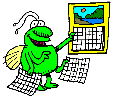Pollination of Plants by Insects
by Rudy Scheibner,
Extension Entomologist
Pollination is the process whereby plants receive pollen from other plants of the same species so that they can reproduce by forming seeds. Some plants are pollinated by the wind, and some are
pollinated by insects or other small animals. When plants are
pollinated by insects, it seems like some kind of agreement was
made whereby the plant will provide the insect with something, if
the insect will pollinate the plant's flowers in return.
Although the plant and the insect may benefit because of their
relationship with each other, the insect visiting a flower
usually does not purposefully pollinate the flower.
Honey bees are very important insect pollinators. Most of the time, both honey bees and the plants they
visit are benefited. The honey bee gets some food and the plant
gets pollinated. When a honey bee is collecting pollen from the anthers (male reproductive part) of a flower, it puts
the pollen in special pollen baskets on its hind legs. All that
pollen will be taken back to the hive for the bees' use. The honey bee is a messy gatherer of food, and some pollen gets stuck on
the hairs of its body. When the bee visits the next flower, some
of that pollen brushes off onto the flower and if it sticks to the stigma (female reproductive part) of the flower, pollination will take place. The bee
does not make any effort to put the pollen in the right place.
Bees also gather pollen from corn, but the corn gets nothing
in return. Corn is pollinated by the wind. When honey bees try
to get nectar from an alfalfa flower, the flower has a tripping
device that slaps the bee in the face with an anther (the pollen-bearing part of a flower). That's the flower's way of assuring
that its pollen gets attached to an insect for transfer to
another flower. The bees don't like being slapped in the face,
so they usually find some other kind of plant to get nectar.
Some of the bees learn to chew a hole in the side of the flower
and get to the nectar through this side door. When they do that,
pollination does not occur because the pollen on the bee does not reach the top of the stigma. So it seems that the only reason a
bee visits a flower is to get what it wants and not to perform a
pollination service. Pollination occurs as a happy accident for
the flower.
Many other kinds of insects, such as wasps, flies, beetles,
thrips and other kinds of bees that feed on nectar or pollen also
pollinate flowers by accident. However there are at least some
insects that intentionally see to it that the flowers they visit
get pollinated. The way a yucca flower is built, it cannot be
pollinated in the ordinary way, and it depends on the special
service of a yucca moth to do it. When the moth comes to a yucca
flower it gathers up a ball of pollen, and then goes to the ovary
of the female part of the flower where it lays some eggs.
It then climbs to the top of the female part of the flower and
places the ball of pollen on the stigma where it needs to be for
pollination to occur. Now that it is pollinated, the flower can
produce seeds in its ovary. The yucca moth caterpillars eat some
of the seeds, but many are left over to produce new yucca plants.
Because the yucca moth caterpillars eat only yucca seeds, and the
yucca plant is pollinated only by yucca moths, both the moths and
the plant depend on each other for survival.
Insects All Year cartoon courtesy of C. Ware, copyright 1998
Last updated: 21 January 1999
|
















 Return to UK Department of Entomology Katerpillars page
Return to UK Department of Entomology Katerpillars page